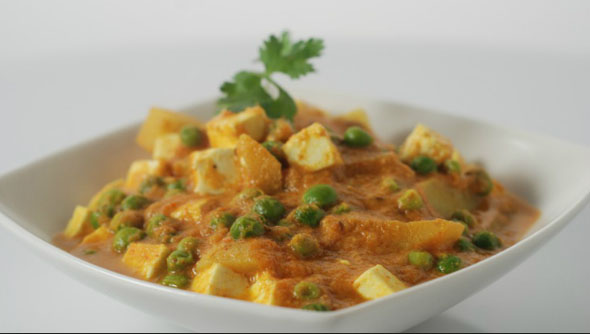Mama’s Punjabi Recipes: Mutter Paneer di Turri (Peas & Indian Cheese Curry)
There is probably not a single Indian restaurant in the US, and probably in the world, which does not make sag paneer (also called palak paneer), since it is mild enough for the kids, yet still has just the right spices for a truly Indian flavor. But the use of paneer has grown immensely as its popularity has grown. In India, as people have become richer, they don’t mind paying the premium for paneer dishes. It is not uncommon to go to even a Punjabi dhabba and find three or four paneer dishes on the menu.
Paneer (fresh milk soft cheese) is an unaged, acid-set, non-melting farmer cheese made by curdling hot milk with lemon juice or vinegar to separate the whey. Many people buy the ready made paneer, even in India, although it is quite simple but time consuming to make. Paneer adds a special zest to even simple dishes, and many restaurants make it with added cream to thicken the gravy.
Some ingredients make for an interesting combination with paneer, like mutter (peas) paneer; karahi paneer, khumban (mushroom) paneer and the favorite paneer tikka masala. But, of all these, khumban and mutter are the two most common curries made in Indian homes, because these are simple and fast to make, especially if guests suddenly show up at the door! All you need is to keep the peas and paneer (already cut into squares) handy in the freezer!
The secret behind a good dish is to make sure that the paneer does not break when placed in the curry. For this reason, it is important to take the extra step of gently stir-frying the paneer, although in India, most eating establishments will deep fry the paneer, to get a crispy exterior skin.
Ingredients:
200 gm mutter (green peas) frozen or fresh
250 gm paneer (Indian cheese) cut into square cubes
2 medium tamater (tomato) soft ones are best, chopped
1 small pyaaz (onion) peeled and finely chopped
½ teaspoon of lasan (garlic) powder (if desired)
1 small piece of adrak (ginger) peeled and finely chopped
3 tablespoons of vegetable or olive oil
Spices (to taste): namak (salt), mirch (red pepper), haldi (turmeric), fresh dhania (coriander), garam masala
Directions:
1. Place a tablespoon of oil in a frying pan and warm it up on medium heat.
2. Place the cubes of paneer in the frying pan and brown both sides slightly. Take off the heat and place on a plate to cool down.
3. Prepare the masala in a medium saucepan. Heat 2 tablespoons of oil over medium heat, then add the onions, ginger, garlic and tomatoes. Stir well to make sure it doesn’t stick to the bottom. When the mixture is slightly brown, add the salt, pepper and haldi and stir well.
4. Throw in the peas and stir well to coat and cook for a few minutes. If frozen, then let the peas thaw out first before using and cook for 5 minutes. If fresh, then let the peas cook a little longer in the saucepan.
5. Throw in the paneer and stir to coat well and let it cook for 2 minutes.
6. Add the water and bring it to a boil for 2 minutes. Turn the heat off, cover the saucepan and let it sit for five minutes.
7. Before serving, garnish the dish with garam masala and the shredded fresh dhania.
MAMA’S TIP OF THE WEEK
TO KEEP RAITA SWEET, NOT SOUR, DON’T THROW IN THE SALT
Its quite common to have raita (thinned out yogurt with garnishes) with many Indian dishes and often, there is quite a lot left over as it is supposed to be a complement to rice or some savory hot paranthas. Many times though, many people discover that the raita has turned sour within a day or two and cannot be eaten.
The reason for the raita turning sour is due to putting salt into it when it is first being served. It is better to leave the salt out and let people sprinkle the salt over the portions they take rather than to salt the entire raita. This way, the remaining raita can stay sweet in the refrigerator for a longer time.
Shakuntla Malhotra is a skilled cook of Punjabi dishes made in the old-fashioned style that she learnt as a young woman in her ancestral home in Lyallpur, India before it became part of Pakistan after the Partition in 1947. People have often admired her cooking for its simplicity and taste that comes with each mouthful. Even in her mid-eighties, she continues to cook daily and agreed to share some of her delectable Punjabi recipes.


